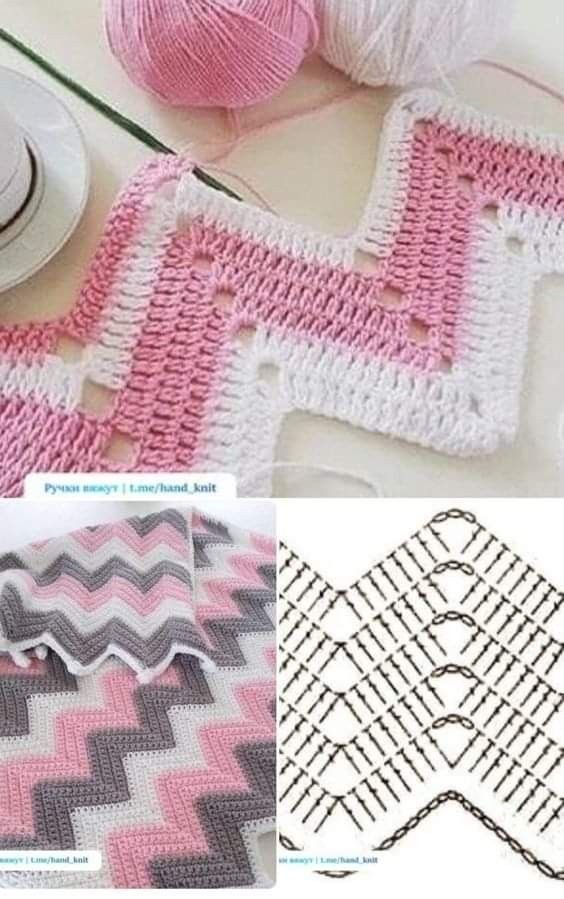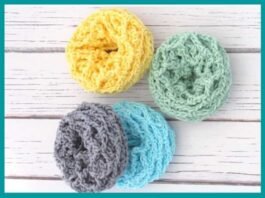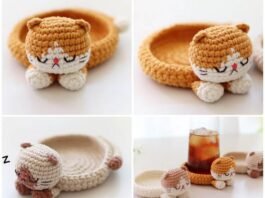The Zig Zag Stitch in Crochet – Pattern is one of the most visually striking and versatile techniques in the world of crochet.
Recognized for its wave-like, chevron appearance, this stitch adds rhythm and movement to any project, making it ideal for blankets, scarves, cushions, and more.
Whether you’re just beginning your crochet journey or have years of experience, the Zig Zag Stitch in Crochet – Pattern offers an exciting way to explore texture and color. Its unique shape makes it perfect for both monochromatic elegance and bold, colorful stripes.

In this article, we’ll walk through everything you need to know about working the Zig Zag Stitch in Crochet – Pattern, including how it’s constructed, the materials you’ll need, creative ideas for using it, and expert tips to help you master it. Let’s dive into the flow and flair of this timeless crochet favorite.
1. What is the Zig Zag Stitch in Crochet – Pattern?
The Zig Zag Stitch in Crochet – Pattern is a variation of a ripple or chevron pattern, characterized by peaks and valleys created through strategic increases and decreases. This stitch is known by several names, including ripple stitch, chevron stitch, or wave stitch, but all share a similar structural foundation.
Unlike straight-edged rows, the zig zag pattern naturally forms a wavy design as you crochet back and forth. It’s both visually dynamic and relaxing to work on, thanks to its repetitive yet engaging structure.
The pattern typically starts with a foundation chain that is a multiple of a specific number (often 14 or 17), plus a few additional stitches for turning. These multiples ensure the increases and decreases align correctly to create the zig zag effect.
Increases are usually worked by placing multiple stitches in a single space, forming the “peaks,” while decreases involve crocheting stitches together to create the “valleys.” These shaping techniques define the wave-like motion of the pattern.
The Zig Zag Stitch in Crochet – Pattern is popular in both vintage and modern projects. Its bold lines and clean angles offer plenty of opportunity to experiment with color changes, texture combinations, and stitch variations.
Because of its strong visual impact, this pattern is often used in larger projects like afghans and throws, where the zig zag motif can truly shine. But it’s also stunning in smaller pieces like scarves or table runners.
2. How to Work the Zig Zag Stitch in Crochet
To start your Zig Zag Stitch in Crochet – Pattern, you’ll need worsted weight yarn (or your preferred yarn type), a compatible crochet hook (typically 5.0mm/H-8 for worsted yarn), and a yarn needle for weaving in ends. Choose two or more colors if you plan on adding stripes.
Begin with a foundation chain that is a multiple of the required number (for example, 14 x number of pattern repeats) plus a few extra chains for turning. Count carefully—this step is essential for keeping the pattern symmetrical.
In the first row, you’ll work a sequence of double crochet stitches (US terms), decreasing two stitches at the bottom of each valley and increasing by placing three stitches in one at each peak. This combination of increases and decreases forms the zig zag structure.
Subsequent rows repeat this pattern, stacking the peaks and valleys to maintain the wave shape. Pay close attention to stitch placement—placing increases and decreases correctly is key to keeping the pattern aligned and looking neat.
Switching colors every few rows adds a beautiful striped effect. Always carry your yarn up the side or cut and rejoin cleanly depending on the project’s edge finish. This can dramatically enhance the visual flow of the zig zag design.
To finish, weave in all ends securely and block your piece if necessary to smooth out the zig zags and enhance the overall shape. This is especially important for wearable or decorative items where a crisp finish is desired.
3. Creative Project Ideas Using the Zig Zag Stitch
The Zig Zag Stitch in Crochet – Pattern is incredibly adaptable, making it a great choice for a wide range of projects. Its rhythmic pattern adds movement and personality to everything from home décor to fashion accessories.
Blankets and Afghans are perhaps the most common uses. Whether you’re making a baby blanket or a king-size throw, the zig zag design looks stunning in solid colors, pastels, or bold rainbow stripes.
For wearable items, consider a scarf or shawl. The angular lines of the zig zag pattern lend themselves beautifully to long, flowing accessories. Use gradient or variegated yarn for a shifting color effect.
The pattern also works well in table runners and placemats, adding handmade charm and a touch of vintage flair to your dining setup. Choose colors that complement your home’s interior for a coordinated look.
Create fun and colorful crochet pillows by making front and back panels using the zig zag pattern. Mix different stitch heights or yarn textures for added interest and a more textured feel.
You can even design a crochet tote bag with a zig zag base or panel. The sturdy texture and structured form of the pattern help the bag hold its shape, and the design adds a playful touch.
Finally, try making a rug or bathmat using the zig zag stitch with thick cotton or t-shirt yarn. This turns a functional item into a cheerful statement piece for any room in the house.
4. Tips for Perfecting the Zig Zag Stitch in Crochet
Like any technique, the Zig Zag Stitch in Crochet – Pattern has a few quirks that you can master with some practice and planning. Here are some expert tips to help you create clean, balanced zig zags every time.
Always count your stitches. This pattern relies heavily on precision. Even one extra or missing stitch can throw off the symmetry, so count each row to ensure consistency across your project.
Use stitch markers to mark the beginning of each repeat section or to identify your peaks and valleys. This is especially useful in larger projects or for beginners who need a visual guide.
Practice tension control. Because the stitch involves both increases and decreases, maintaining even tension helps keep your rows uniform in width and prevents curling or puckering.
Experiment with color changes, but plan them in advance. Zig zags naturally highlight color shifts, so switching colors at regular intervals can give your project a bold, rhythmic design. Try single stripes, gradient fades, or even rainbow transitions.
Try different stitch heights to modify the look. While double crochet is standard, using half double or treble stitches can alter the scale and density of the zig zag, giving you more design freedom.
Lastly, block your finished project. Especially for garments or décor, blocking ensures your zig zag edges are sharp and smooth. It enhances the final presentation and makes all your hard work stand out beautifully.
FAQ – Zig Zag Stitch in Crochet – Pattern
Q1: Is the Zig Zag Stitch in Crochet – Pattern beginner-friendly?
Yes! While it may look complex, it only requires basic stitches like chain, double crochet, and decreases. With some patience and counting, even beginners can master it.
Q2: What is the best yarn for zig zag crochet?
Worsted weight yarn is the most popular for this stitch. However, any yarn can be used as long as you match it with the appropriate hook size for even tension and drape.
Q3: Can I change colors in the middle of a zig zag row?
Yes, but it’s best to change colors at the beginning of a new row to keep the edges clean. If you prefer changing mid-row, make sure to do so at the same point in each repeat for consistency.
Q4: Why is my zig zag pattern curling?
Curling usually results from tight tension or inconsistent stitch height. Try loosening your grip slightly and make sure you’re using the same stitch height throughout.
Q5: How do I calculate the starting chain for a specific width?
Multiply the pattern repeat count (e.g., 14 stitches per repeat) by the number of desired zig zags, then add the recommended extra stitches for turning. Swatching is helpful to test your width before beginning.
Q6: What projects are best suited for the Zig Zag Stitch in Crochet – Pattern?
Blankets, scarves, shawls, table runners, tote bags, rugs, and cushions are all ideal. The pattern’s adaptability makes it suitable for a wide variety of functional and decorative items.
Conclusion
The Zig Zag Stitch in Crochet – Pattern is a lively and versatile technique that brings energy and movement to any crochet project. From bold, colorful blankets to chic accessories and thoughtful gifts, this stitch offers endless creative possibilities.
In this article, we explored what the pattern is, how to work it, project ideas to inspire your next make, and expert tips to help perfect your craft. With just a few basic stitches and a bit of practice, you can create beautiful pieces that showcase the elegance of this timeless pattern.
If you enjoyed this article or tried the pattern, we’d love to hear from you. Please leave a sincere opinion below and share your tips, feedback, or project photos. Your input helps us continue providing valuable, creative content for the crochet community. Happy stitching!





